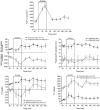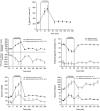Regional fat metabolism in human splanchnic and adipose tissues; the effect of exercise
- PMID: 12231657
- PMCID: PMC2290532
- DOI: 10.1113/jphysiol.2002.022392
Regional fat metabolism in human splanchnic and adipose tissues; the effect of exercise
Abstract
This study was conducted to investigate the role of splanchnic and adipose tissue in the regulation of fatty acid (FA) metabolism at rest, during 1 h of semi-recumbent cycle exercise at 60 % of maximal power output and 3 h of recovery. In six post-absorptive healthy volunteers catheters were placed in a radial artery, hepatic vein and a subcutaneous vein on the anterior abdominal wall. Whole body, and regional splanchnic and adipose tissue FA metabolism were measured by a constant infusion of the stable isotopes [U-(13)C]palmitate and [(2)H(5)]glycerol and according to Fick's principle. The whole body rate of extracellular FA reesterification was similar at rest and during exercise (approximately 290 micromol min(-1)) and increased during recovery to a plateau of 390 micromol min(-1). FA and triacylglycerol (TAG) uptake by adipose tissue was undetectable, but a constant but small glycerol uptake of approximately 25 nmol (100 g)(-1) min(-1) was observed. From the FA taken up by the splanchnic area, 13 % was oxidized, 5-11 % converted to ketone bodies, and approximately 35 % incorporated in TAG released both at rest and at the third hour of recovery from exercise. Splanchnic FA reesterification could account for 51 % and 58 % of whole body extracellular FA reesterification, of which half was accounted for by TAG released from the splanchnic area, at rest and in recovery, respectively. In conclusion, in the post-absorptive state, adipose tissue contributes very little to extracellular FA reesterification and splanchnic reesterification can account for 50-60 %, implying that FA reesterification in other tissues is important. The extracellular FA reesterification rate does not change with exercise but is higher during recovery. Furthermore, the uptake of glycerol by adipose tissue indicates that adipose tissue can metabolize glycerol.
Figures







Similar articles
-
Human skeletal muscle fatty acid and glycerol metabolism during rest, exercise and recovery.J Physiol. 2002 Sep 15;543(Pt 3):1047-58. doi: 10.1113/jphysiol.2002.023796. J Physiol. 2002. PMID: 12231658 Free PMC article.
-
Metabolic effects of interleukin-6 in human splanchnic and adipose tissue.J Physiol. 2002 Aug 15;543(Pt 1):379-86. doi: 10.1113/jphysiol.2002.021022. J Physiol. 2002. PMID: 12181308 Free PMC article. Clinical Trial.
-
The effect of exercise on regional adipose tissue and splanchnic lipid metabolism in overweight type 2 diabetic subjects.Diabetologia. 2004 Apr;47(4):652-9. doi: 10.1007/s00125-004-1374-y. Diabetologia. 2004. PMID: 15298342 Clinical Trial.
-
Glycerol production and utilization measured using stable isotopes.Proc Nutr Soc. 1999 Nov;58(4):973-8. doi: 10.1017/s0029665199001287. Proc Nutr Soc. 1999. PMID: 10817165 Review.
-
Macronutrient metabolism of adipose tissue at rest and during exercise: a methodological viewpoint.Proc Nutr Soc. 1999 Nov;58(4):877-86. doi: 10.1017/s0029665199001184. Proc Nutr Soc. 1999. PMID: 10817155 Review.
Cited by
-
Impact of skeletal muscle IL-6 on subcutaneous and visceral adipose tissue metabolism immediately after high- and moderate-intensity exercises.Pflugers Arch. 2020 Feb;472(2):217-233. doi: 10.1007/s00424-019-02332-w. Epub 2019 Nov 28. Pflugers Arch. 2020. PMID: 31781893
-
Impaired lipolysis in propionic acidemia: A new metabolic myopathy?JIMD Rep. 2020 Mar 31;53(1):16-21. doi: 10.1002/jmd2.12113. eCollection 2020 May. JIMD Rep. 2020. PMID: 32395405 Free PMC article.
-
The effect of aerobic exercise on intrahepatocellular and intramyocellular lipids in healthy subjects.PLoS One. 2013 Aug 14;8(8):e70865. doi: 10.1371/journal.pone.0070865. eCollection 2013. PLoS One. 2013. PMID: 23967125 Free PMC article. Clinical Trial.
-
The Importance of Fatty Acids as Nutrients during Post-Exercise Recovery.Nutrients. 2020 Jan 21;12(2):280. doi: 10.3390/nu12020280. Nutrients. 2020. PMID: 31973165 Free PMC article. Review.
-
A heterogeneous response of liver and skeletal muscle fat to the combination of a Paleolithic diet and exercise in obese individuals with type 2 diabetes: a randomised controlled trial.Diabetologia. 2018 Jul;61(7):1548-1559. doi: 10.1007/s00125-018-4618-y. Epub 2018 Apr 26. Diabetologia. 2018. PMID: 29696296 Free PMC article. Clinical Trial.
References
-
- Boberg J, Carlson LA, Freyschuss U. Determination of splanchnic secretion rate of plasma triglycerides and of total and splanchnic turnover of plasma fatty acids in man. European Journal of Clinical Investigations. 1972;2:123–132. - PubMed
-
- Bülow J. Measurement of adipose tissue blood flow. Methods in Molecular Biology. 2001;155:281–293. - PubMed
-
- Bülow J, Jelnes R, Atrup A, Madsen JVP. Tissue/blood partition coefficients for xenon in various adipose tissue in man. Scandinavian Journal of Clinical and Laboratory Investigations. 1987;47:1–3. - PubMed
-
- Bülow J, Simonsen L, Wiggins D, Humphreys SM, Frayn KN, Powell D, Gibbons GF. Co-ordination of hepatic and adipose tissue lipid metabolism after oral glucose. Journal of Lipid Research. 1999;40:2034–2043. - PubMed
Publication types
MeSH terms
Substances
LinkOut - more resources
Full Text Sources
Other Literature Sources
Medical
Miscellaneous

